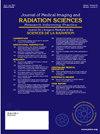Signal Power Estimation and its Novel Applications in Radiology as two birds with one stone
IF 1.3
Q3 RADIOLOGY, NUCLEAR MEDICINE & MEDICAL IMAGING
Journal of Medical Imaging and Radiation Sciences
Pub Date : 2024-10-01
DOI:10.1016/j.jmir.2024.101480
引用次数: 0
Abstract
Background/Purpose
In radiology, MTF and SNR (or CNR) are known as established methods for evaluating the quality of phantom images. However, due to their complexity caused by multiple procedures involved in measuring of multiple ROI statistics such as mean, variance, etc., this study proposes a simplified signal power estimation method calculated directly from a pair of observed images. Then, in this research, MTF* and SNR* utilizing this proposed method are introduced as novel applications.
Methods
First, two observed phantom images are prepared by using the same imaging condition. Then, a signal power of the image is estimated from a covariance of a pair of the observed images using the following equation. V(x) = Cov(y1, y2) where V(·) and Cov(·) denote a variance and a covariance of · respectively. Here, x is a signal image vector, and y1 and y2 are observed image vectors obtained under the same imaging conditions, where y is constructed from the signal vector x summated the additive noise vector n, namely y = x + n. Finally, MTF* and SNR* are calculated using the estimated signal power V(x). The proposed methods are then compared with the conventional methods.
Results
While a direct comparison between conventional SNR and SNR* proved difficult due to differences in definition, both methods showed similar trends. On the other hand, the conventional MTF by Droege's method and the MTF* were almost in agreement with two significant figures as expected.
Conclusion
This investigation proposed simplified method for estimating signal power derived from the covariance of a pair of observed images. And this proposed method produced novel applications termed MTF* and SNR*, and has an more practical than the conventional method in terms of simplified procedure as two birds with one stone.
一石二鸟的信号功率估计及其在放射学中的新应用
背景/目的在放射学中,众所周知,MTF 和 SNR(或 CNR)是评估模型图像质量的既定方法。然而,由于测量多个 ROI 统计数据(如均值、方差等)涉及多个程序,因而非常复杂,因此本研究提出了一种简化的信号功率估计方法,该方法直接从一对观察图像中计算信号功率。方法首先,使用相同的成像条件准备两幅观察到的幻影图像。然后,根据一对观测图像的协方差,利用下式估算图像的信号功率。V(x) = Cov(y1, y2) 其中 V(-) 和 Cov(-) 分别表示-的方差和协方差。这里,x 是信号图像向量,y1 和 y2 是在相同成像条件下获得的观测图像向量,其中 y 由信号向量 x 加上加性噪声向量 n 构建而成,即 y = x + n。最后,利用估计的信号功率 V(x) 计算 MTF* 和信噪比*。结果由于定义不同,很难直接比较传统的信噪比和信噪比*,但这两种方法显示出相似的趋势。另一方面,采用 Droege 方法得出的传统 MTF 与 MTF* 几乎一致,都达到了预期的两位有效数字。这种方法产生了新的应用,即 MTF* 和 SNR*,在简化程序方面比传统方法更实用,可谓一石二鸟。
本文章由计算机程序翻译,如有差异,请以英文原文为准。
求助全文
约1分钟内获得全文
求助全文
来源期刊

Journal of Medical Imaging and Radiation Sciences
RADIOLOGY, NUCLEAR MEDICINE & MEDICAL IMAGING-
CiteScore
2.30
自引率
11.10%
发文量
231
审稿时长
53 days
期刊介绍:
Journal of Medical Imaging and Radiation Sciences is the official peer-reviewed journal of the Canadian Association of Medical Radiation Technologists. This journal is published four times a year and is circulated to approximately 11,000 medical radiation technologists, libraries and radiology departments throughout Canada, the United States and overseas. The Journal publishes articles on recent research, new technology and techniques, professional practices, technologists viewpoints as well as relevant book reviews.
 求助内容:
求助内容: 应助结果提醒方式:
应助结果提醒方式:


